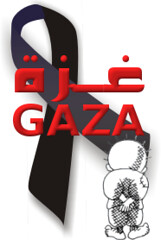ok, so where to begin. We recently returned from our 8 day trip to Puerto Rico. I'm still moping about why I am back in dreary Durham as opposed to warm and welcoming Puerto Rico, and that has somewhat hindered my progress in blogging about my experience there (that, and one too many late night dinner parties hosted by the burgeoning Palestinian community there...suffice to say, I am all
kharoofed out for the season!). Honestly, we need a vacation from our vacation!
The purpose of the trip was to give a talk at Sacred Heart University (Universidad Sacredo Corazon)'s Center for Freedom of the Press.
The talk took place the evening of Monday, February 9th, following a day of interviews with local press, including
this one in
WAPA TV Puerto Rico, by journalist Julio Rivera-Saniel (notice my incessant arm-flailing-as though there were an invisible fly I were trying to swat), and a very thoughtful
lengthier piece in his personal blog (he actually got all the details of my seemingly nonsensical life correct so I must give him some credit!!).
In short, it was a tremendous success. I was absolutely overwhelmed by the reception I got and by the unprecedented attendance- organizers estimated that up to 1000 people showed up, and 500 others had to be turned away for lack of room (both in the parking lot and the two rooms that were filled to capacity). Never in the history of the Center have so many people showed up to an event.
It was clear the people of Puerto Rico were thirsty for knowledge about the Palestinian conflict, and have a deep sense of the injustice of it all. What was even more remarkable was the diversity of the attendance: traditionally, I was told, it is the Independentista, supporters of the Puerto Rican Independence Party, or Partido Independentista Puertorriqueño (PIP) that make up about 5% of voters only, who would attend such functions, relating on many levels to the Palestinian situation and their struggle for statehood (but as one man later pointed out to me-
"In your case it's not only the struggle for sovereignty but also a struggle to obtain a minimum of Basic Human Rights."
Another NY blogger of Puerto Rican heritage added:
"The Taino (the indigenous of Puerto Rico) welcomed the first European invaders. In exchange, the Taino were greeted with an unrelenting Holocaust. After 500 years of systematic efforts to destroy the Taino, it's only recently that a Taino identity is beginning to re-emerge. Unfortunately, we have so little left. The land was taken and our customs and language were obliterated. But slowly bits and pieces of our lost heritage--along w/DNA evidence--are helping us reclaim our true heritage. However, progress is hindered by the propaganda of Puerto Rico's ruling families--which are of European heritage--that the Taino were eliminated."
He also related the the similar experiences of Mexican-AMericans in Texas.
Back to the talk-participation was across the board I was told. People from all backgrounds and level of knowledge appeared. I was particularly touched a Puerto Rican man of Taino heritage who brought his young 8-year-old daughter with him (she later asked for my autograph :)).
The talk was without incident, barring an eruption at the end by an Israeli right-winger who -in true Zionist fashion- occupied the podium, took over the microphone and demanded to be heard, before being asking to respect the Q&A procedures.
We spent the rest of the week in the welcoming hands of the Puerto Rican Palestinian and Muslim communities. They make up roughly 5000 inhabitants on the island. Most of the Palestinians are third generation, descendants of immigrants from villages surrounding Ramallah. Many work in the pharmaceutical industry that is the underpinning of the Puerto Rican Economy (and inf act Palestinians own the second largest chain of pharmacies there, El-Amal). Many started out in Columbia or New York and ended up in Puerto Rico, where their amicability and forgiving business habits helped them gain favor with the locals.
On Sunday we were invited to speak to the the Farouk Mosque in Vega Alta, a suburb of San Juan. It was stunning, located on a hill top surrounded by banana and grapefruit trees, overlooking the freeway and the rest of the island. In attendence were also a group of native Puerto Rican Muslims.
We did manage to sneak out and enjoy ourselves for at least two days. We took a ferry to the island of Culebra just off the coast of Puerto Rico, where we spent one rainy day indoors as well as exploring the gastronomical topography of the island, witch oregano, belladonnas, star fruit trees, and all, and ended up making up our own rice pudding recipe with local hibiscus leaves, star fruit and fresh coconut and passion fruit fruit juice (courtesy of the juice man across the casita from where we were staying). We spent the next day on the stunning Playa Flamenco.
Earlier in the week, we had an opportunity to view an outdoor photography exhibit, "Earth From Above", by artist-activist Yann Arthus-Bertrand, of 150 four-foot by six-foot aerial photographs of the Earth and our world (in case you are wondering, that's a photo of a man taking a nap on an enormous pile of freshly picked and bundled cotton- not a cauliflower).
Yousuf practiced his own photography skills- snapping a revealing (I'm kidding) photo of my legs, and a vendor selling peeled oranges on the main promenade in Old San Juan.






































.JPG)





